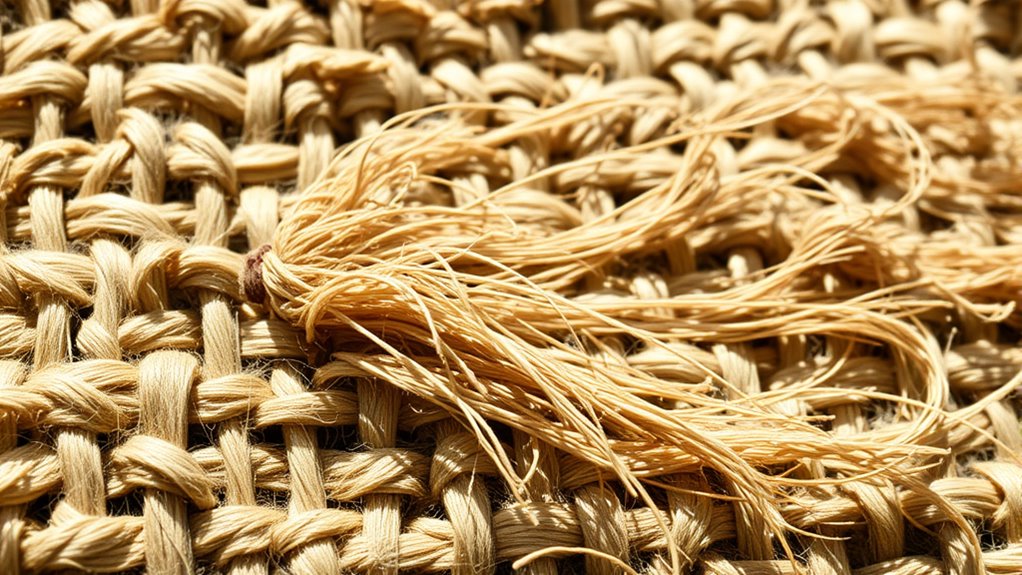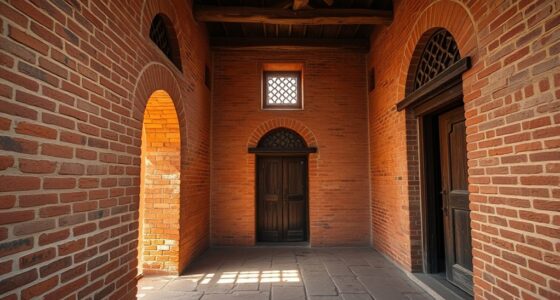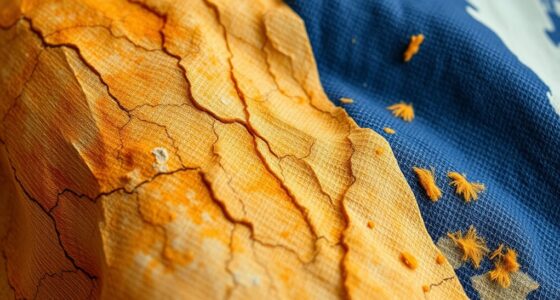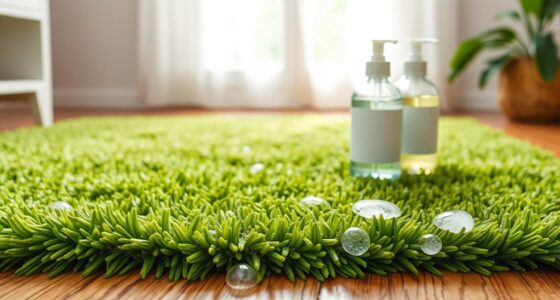Sustainable rugs made from hemp and nettle fibers are eco-friendly choices that combine durability, natural aesthetics, and traditional techniques. Hemp requires minimal water and pesticides, offering strength and longevity, while nettle fibers, an ancient material, support cultural preservation and biodegradability. Both fibers bring rustic charm and versatility to various interior styles. If you want to understand how these materials contribute to sustainability and craftsmanship, keep exploring the benefits and challenges they present.
Key Takeaways
- Hemp and nettle fibers are eco-friendly, renewable, biodegradable materials that reduce environmental impact in rug production.
- These natural fibers offer durability, high tensile strength, and low maintenance, ensuring long-lasting rugs.
- Cultivation of hemp and nettle requires minimal water, pesticides, and fertilizers, supporting sustainable farming practices.
- Traditional weaving and natural dye techniques preserve cultural heritage and enhance aesthetic versatility.
- Innovations in processing, eco-friendly adhesives, and recycling are advancing the sustainability of hemp and nettle rugs.
The Rise of Eco-Friendly Rug Materials
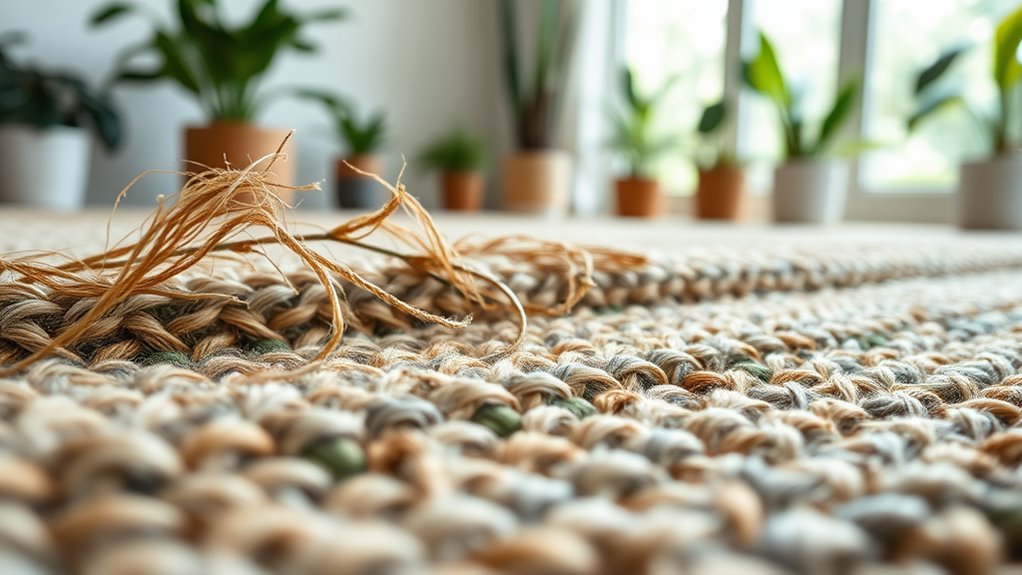
As awareness of environmental issues grows, more rug manufacturers are turning to eco-friendly materials to meet consumer demand. Traditional weaving methods, combined with natural dye techniques, play a key role in this shift. Instead of synthetic fibers, artisans now use sustainable fibers like hemp and nettle, which are renewable and biodegradable. These materials often involve traditional weaving practices that have been passed down through generations, ensuring both cultural preservation and eco-conscious production. Natural dye techniques, using plant-based colors, enhance the sustainability of these rugs by avoiding harmful chemicals. Additionally, incorporating Hopi Tribe weaving traditions into modern designs helps support cultural heritage and promote sustainable practices. The use of traditional craftsmanship emphasizes the importance of maintaining artisanal skills in sustainable production. Moreover, adopting eco-conscious manufacturing methods can further reduce environmental impact and promote responsible resource management. Utilizing energy-efficient appliances in the manufacturing process can help reduce overall power consumption and carbon footprint. By embracing these methods, manufacturers create beautiful, durable rugs that reduce environmental impact while honoring traditional craftsmanship. This movement reflects a broader effort to make the rug industry more sustainable and eco-aware.
Advantages of Using Hemp in Rug Production
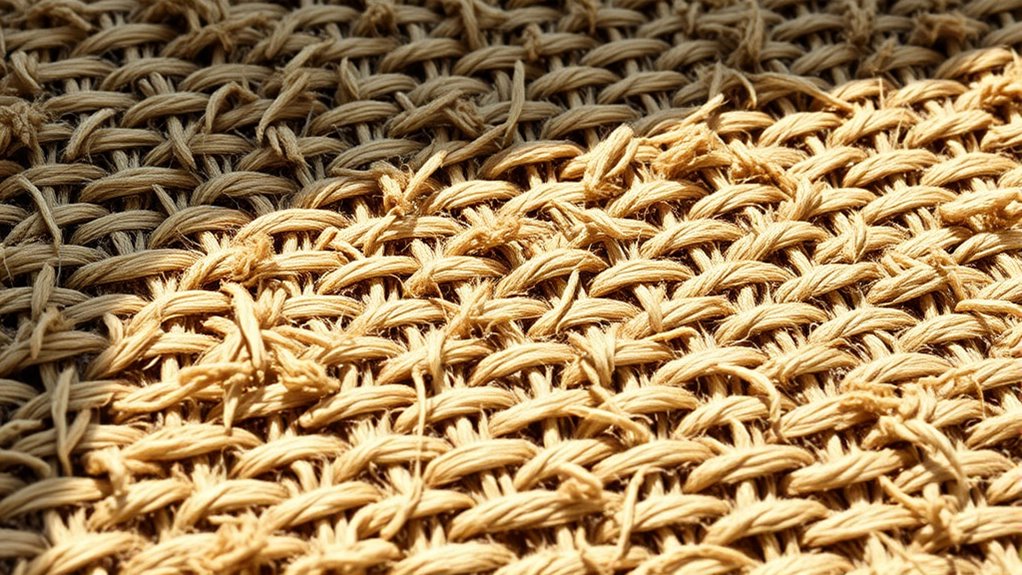
Hemp is an eco-friendly crop that requires fewer resources to grow, making it a sustainable choice for rug production. Its natural strength and durability mean your rug will last longer without sacrificing quality. Plus, hemp rugs are low maintenance, so you can enjoy their benefits with minimal effort. Additionally, hemp’s industrial heritage aligns with the vintage-inspired aesthetic of Victoriana and Steampunk designs, adding a unique charm to your decor. Its low environmental impact further supports sustainable living and eco-conscious choices. Moreover, hemp’s versatility in design allows for a wide range of aesthetic styles, making it suitable for various interior themes. The ability to participate in remote hackathons can also foster innovation in sustainable materials development, promoting eco-friendly solutions across industries.
Eco-Friendly Cultivation Benefits
Using hemp in rug production offers significant eco-friendly benefits, especially since it requires minimal water and no pesticides to grow. Hemp’s cultivation improves soil health by preventing erosion and enriching the soil with nutrients. Additionally, hemp grows quickly, making it ideal for crop rotation, which reduces the need for chemical inputs and maintains sustainable farming practices. Its dense root system helps aerate the soil, promoting better crop yields. Plus, hemp’s low water needs conserve resources and lessen environmental impact. Sustainable farming practices can be supported by choosing hemp, which benefits the planet and promotes biodiversity.
Durability and Strength
Because of its natural fibers, hemp offers exceptional durability and strength, making it an ideal material for rug production. Its high fiber tensile strength ensures the rug can withstand heavy foot traffic without tearing or fraying. Hemp’s inherent wear resistance means it maintains its appearance longer, resisting pilling and abrasion over time. You’ll find that hemp rugs retain their structural integrity even after years of use, reducing the need for frequent replacements. This robustness makes hemp a practical choice for high-traffic areas in your home or commercial spaces. Its natural resilience not only extends the lifespan of your rug but also contributes to sustainable living by reducing waste. Additionally, hemp’s eco-friendly cultivation methods support sustainable practices in materials production, further emphasizing its benefits. The attention to detail required in quality assurance ensures that each hemp rug meets high standards of durability and quality. Overall, hemp’s durability and strength make it a reliable, eco-friendly option for long-lasting rugs. Incorporating sustainable materials like hemp can also positively impact the environment by reducing reliance on synthetic fibers.
Low Maintenance Needs
Thanks to its natural fibers, hemp rugs not only last longer but also require less upkeep over time. Hemp’s inherent stain resistance makes spills easier to clean, reducing worries about stains. Its dense fibers help repel pet hair, making vacuuming simpler and less frequent. Hemp rugs resist dirt buildup, so they stay fresh longer with minimal cleaning. Additionally, they tend to shed less than synthetic options, saving you time on maintenance. The fiber’s biodegradability also supports environmentally friendly disposal at the end of its lifespan. Moreover, hemp’s durability ensures that rugs maintain their appearance and function even with regular use. Incorporating sustainable materials like hemp can further enhance the eco-friendliness of your home decor. Given the increasing importance of AI safety measures, selecting durable and low-maintenance materials like hemp can contribute to more sustainable and hassle-free home environments.
Nettle Fiber: An Ancient Solution for Modern Sustainability
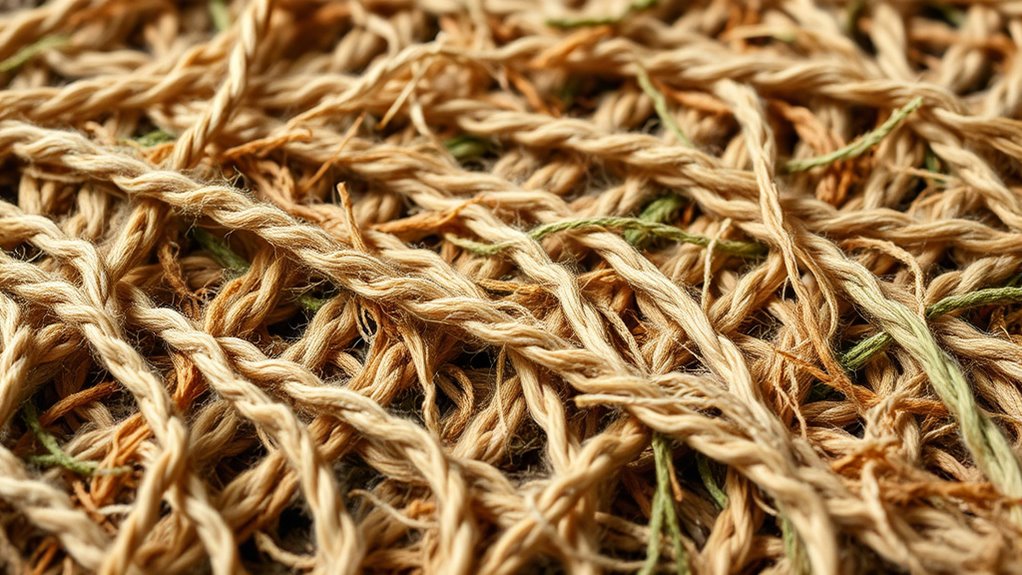
Have you ever considered how ancient plants like nettle can contribute to modern sustainability efforts? Nettle fiber has been used for centuries in traditional weaving, making it a valuable resource for cultural preservation. Its cultivation requires minimal pesticides and fertilizers, reducing environmental impact. Nettle plants grow quickly and abundantly, providing a renewable source of fiber without depleting natural resources. Using nettle in rug-making supports eco-friendly practices while maintaining cultural heritage. This plant’s versatility allows artisans to produce durable, natural textiles that honor traditional techniques. By choosing nettle fiber, you help promote sustainable farming and preserve age-old crafts that connect us to our history. Sustainable farming practices contribute to healthier ecosystems and long-term resource availability. Cultivating nettle can also enhance soil health, preventing erosion and enriching the land with natural nutrients. Additionally, the cultivation of nettle can support biodiversity by creating habitats for beneficial insects and pollinators. It’s a simple yet powerful way to incorporate ecological responsibility and cultural appreciation into modern interior design.
Comparing Durability and Maintenance of Hemp and Nettle Rugs
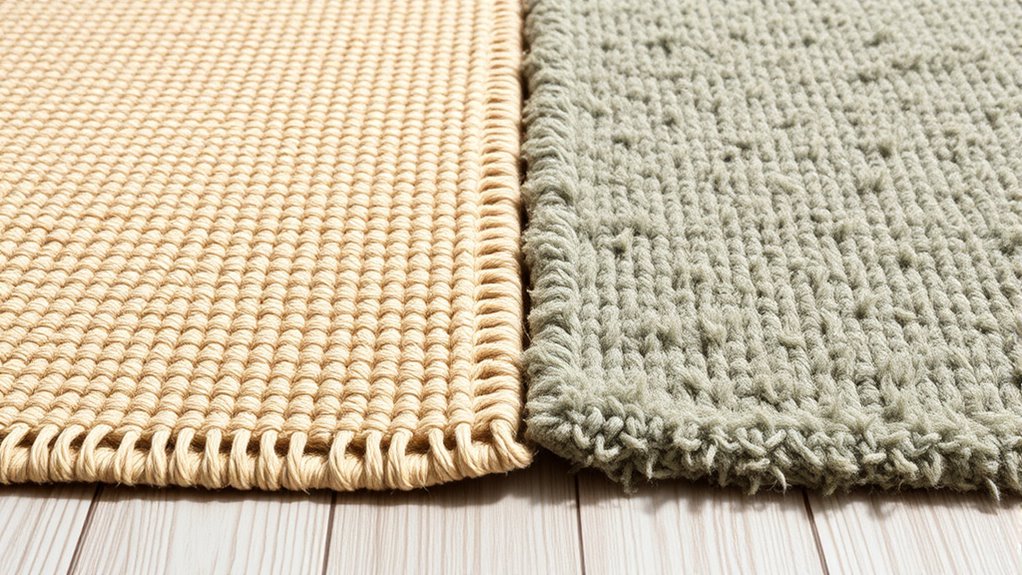
When choosing between hemp and nettle rugs, understanding their durability and maintenance needs is essential. Hemp boasts high fiber strength, making it resistant to wear and tear, while nettle fibers are surprisingly durable but slightly more delicate. For stain resistance, hemp generally performs better due to its natural oils, which repel liquids. To help you compare, consider these points:
- Fiber Strength: Hemp is stronger, ideal for high-traffic areas.
- Stain Resistance: Hemp resists stains more effectively than nettle.
- Maintenance: Both fibers require regular vacuuming, but hemp is easier to clean.
- Longevity: Hemp rugs tend to last longer with proper care, thanks to their fiber strength.
- Cleaning Methods: The natural oils in hemp make it more resistant to moisture, simplifying maintenance over time.
Choosing based on these factors ensures your rug remains functional and attractive over time.
Aesthetic Appeal and Design Possibilities With Natural Fibers
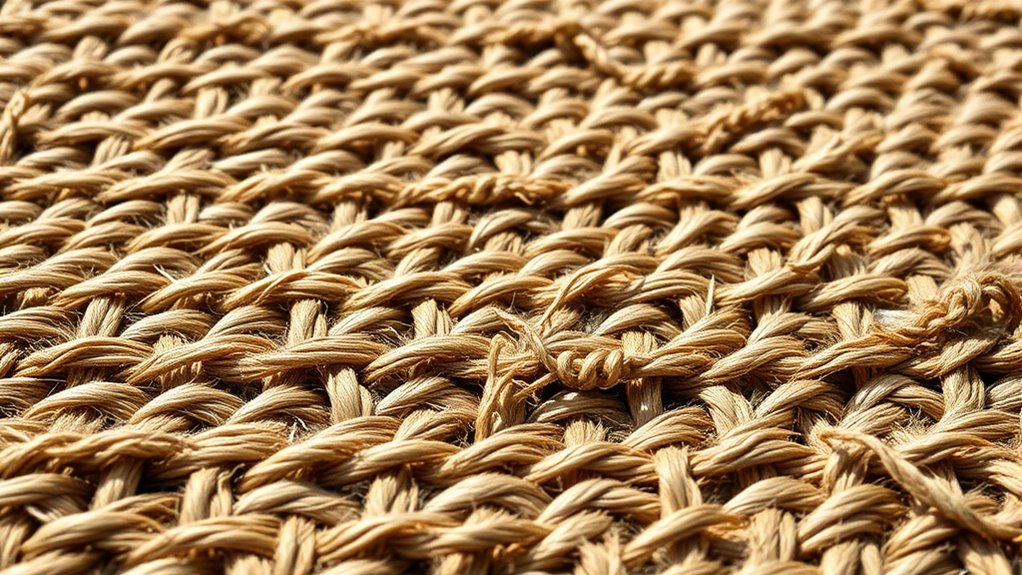
Natural fibers like hemp and nettle not only offer durability but also open up a wide range of aesthetic possibilities for your home. Their unique textures and natural tones create a warm, earthy foundation that complements various color palettes, from neutral to vibrant. You can easily customize your rug’s look with different dyes or finishes, enhancing its visual appeal. Plus, their pattern versatility allows for simple, minimalistic designs or intricate, detailed motifs, giving you flexibility in style. Whether you prefer a modern, rustic, or bohemian vibe, these fibers adapt effortlessly. Their natural appearance adds authenticity and character, making your space feel inviting and thoughtfully curated. Overall, hemp and nettle fibers expand your design options while maintaining a sustainable, stylish aesthetic.
Environmental Impact and Carbon Footprint of Hemp and Nettle

Hemp and nettle are among the most environmentally friendly materials used in rug production because they require considerably less water, land, and chemical inputs compared to traditional fibers. They contribute positively to the environment through efficient carbon sequestration, helping reduce atmospheric CO2 levels. Their cultivation also promotes biodiversity preservation by supporting diverse ecosystems and reducing the need for harmful pesticides.
Here’s how they impact the environment:
- Minimize water and chemical use during growth
- Sequester significant amounts of carbon, lowering climate change impact
- Require less land, reducing deforestation and habitat loss
- Support biodiversity by encouraging diverse plant and insect populations
Choosing hemp and nettle helps you create sustainable rugs while reducing your carbon footprint and protecting ecosystems.
Challenges and Limitations of Using Hemp and Nettle Fibers
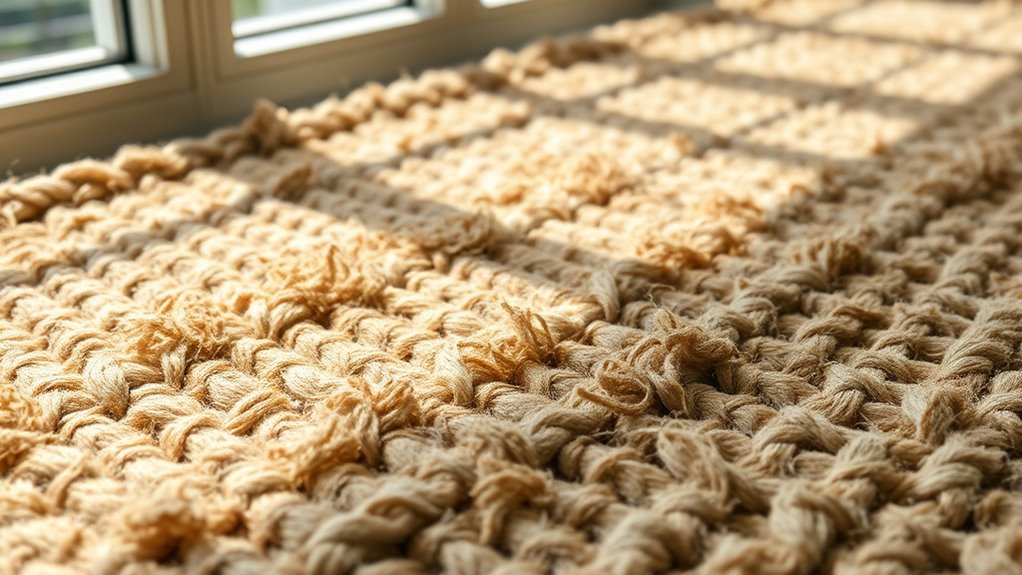
Despite their environmental benefits, hemp and nettle fibers face several challenges that can hinder their widespread use in rug production. One major issue is fiber processing; these fibers often require specialized techniques to separate and refine them, which can be labor-intensive and costly. This complicates the production process and limits scalability. Additionally, market adoption remains slow due to limited consumer awareness and existing preferences for traditional materials. The lack of established supply chains and processing infrastructure further complicates efforts to mainstream these fibers in the rug industry. While their sustainability merits are clear, overcoming these challenges is essential to make hemp and nettle fibers more viable options for manufacturers and consumers alike. Without addressing processing and market barriers, their full potential remains unrealized.
Future Trends and Innovations in Sustainable Rug Manufacturing
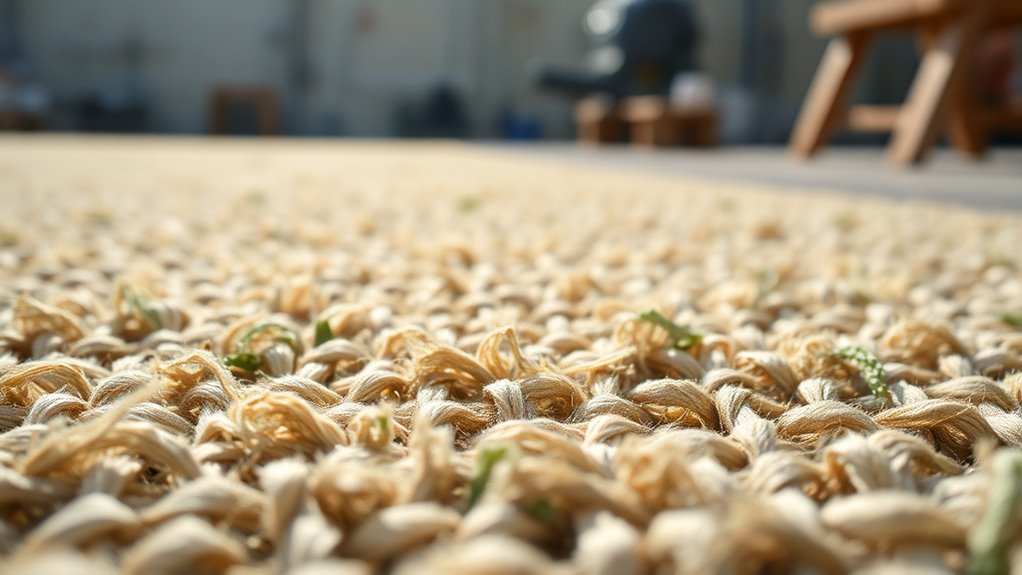
Innovations in sustainable rug manufacturing are rapidly transforming the industry, driven by advances in fiber processing, design techniques, and eco-friendly materials. These developments enhance biodegradability benefits and improve fiber processing techniques, making rugs more eco-conscious. You can expect to see new methods like enzymatic treatments that make fibers more sustainable and easier to recycle. Additionally, innovative designs incorporate biodegradable finishes that reduce environmental impact. Here are some key trends:
- Use of bio-based adhesives and dyes for eco-friendly finishes
- Integration of recycled fibers to enhance sustainability
- Development of biodegradable fibers with improved durability
- Adoption of advanced fiber processing techniques for cleaner production
These innovations help you create rugs that are not only beautiful but also environmentally responsible.
Frequently Asked Questions
Are Hemp and Nettle Fibers Safe for Allergy Sufferers?
You might wonder if hemp and nettle fibers are safe for allergy sufferers. Generally, these fibers have a low allergenic risk because they tend to resist mold and dust mites. However, fiber irritants can still cause reactions if you’re sensitive, especially during processing or handling. It’s best to test a small area first and choose products that are well-cleaned and processed to minimize potential irritants and allergenic risks.
How Do Hemp and Nettle Rugs Compare in Cost to Traditional Rugs?
Imagine you’re stepping into a marketplace in ancient times—today, hemp and nettle rugs often cost more than traditional wool or synthetic options. The pricing comparison shows that their material cost analysis is higher due to eco-friendly farming and processing methods. While they might seem pricier, you benefit from durability and sustainability. Overall, hemp and nettle rugs tend to be slightly more expensive but offer long-term value and environmental benefits.
Can Hemp and Nettle Fibers Be Recycled or Repurposed?
You’ll find that hemp and nettle fibers can be recycled through specialized recycling processes that break down the fibers for reuse. Additionally, repurposing options exist, like transforming old rugs into insulation, paper, or craft materials. These options help reduce waste and extend the life of these eco-friendly fibers. With proper recycling and repurposing, you can guarantee hemp and nettle fibers stay sustainable and environmentally beneficial.
What Are the Washing and Cleaning Requirements for These Natural Fiber Rugs?
For caring for your hemp or nettle fiber rug, follow the care instructions carefully. Regular vacuuming helps prevent dirt buildup, and spot clean stains promptly with a mild detergent. Avoid harsh chemicals or excessive water, as this can damage the fibers. When cleaning, use a damp cloth for stain removal and air dry your rug thoroughly. This keeps it looking fresh and maintains its durability over time.
Are There Any Certifications to Verify the Sustainability of Hemp and Nettle Rugs?
You’ll want to look for certification standards that verify the sustainability of hemp and nettle rugs. These certifications, like GOTS or OEKO-TEX, assess environmental impact and guarantee eco-friendly practices. By choosing rugs with these labels, you can trust they meet strict sustainability criteria. It’s a simple way to support environmentally responsible products and reduce your ecological footprint while enjoying durable, natural fiber rugs.
Conclusion
As you explore eco-friendly rugs, remember these fibers are the seeds of change in your home. Hemp and nettle weave stories of resilience and tradition into modern sustainability, like nature’s own tapestry. By choosing these fibers, you’re planting roots in a greener future—turning your space into a sanctuary of style and purpose. Embrace these natural materials, and let your home become a vibrant garden of conscious living.
